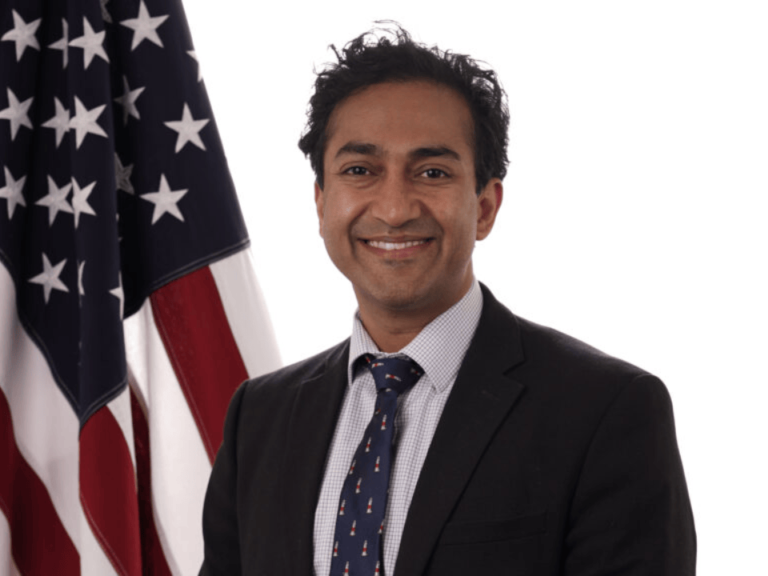The past six weeks have brought fundamental change in the way oncology drugs are being developed.
At this unprecedented moment in oncopolitics, FDA, NCI, academic oncologists, advocates, and the industry are in agreement on how cancer therapies should be developed, tested and approved.
“The current convergence of need, capability, and momentum presents the opportunity to modernize clinical evidence generation practices across government agencies, clinical institutions, research organizations, and pharmaceutical sponsors to build a more efficient, patient-centric system,” Rivera, associate director of pharmacoepidemiology in FDA’s Oncology Center of Excellence and lead of the Oncology Real World Evidence Program, said to The Cancer Letter.
This change has been bubbling beneath the surface for decades, sought by FDA, NCI, advocacy groups, and the industry. Urgency increased as Monica Bertagnolli, a long-time clinical trials group chair, became NCI director. That said, watching events unfold so rapidly, and in such a coordinated fashion, creates an illusion of obviousness and simplicity.
A nascent trial, called Pragmatica-Lung, has emerged as a landmark study that is testing a lead obtained from an innovative master protocol trial (Lung-MAP’s S1800A). The trial is shaping up to combine elements of real-world data, pragmatic design—and, importantly, randomization.
“One hard lesson with making trials more pragmatic is that you have to learn to say no to some interesting trial design elements that are not integral to your main objective. In this instance, we really need to answer one major question, and that is overall survival,” Singh, director of the Division of Oncology 2 in FDA’s Office of Oncologic Diseases and associate director of oncology in older adults and special populations in the Oncology Center of Excellence said to The Cancer Letter.
While Pragmatica-Lung will be conducted by SWOG Cancer Research Network, an NCI-funded group, the new lay of the land in oncology is also an invitation to commercial drug sponsors to launch their own pragmatic trials. Whether conducted by NCI or the industry, these trials can span a broad range of indications.
Following are The Cancer Letter’s recent stories on these landmark developments:
- FDA, NCI align to simplify clinical research, producing a model “pragmatic” registration trial in NSCLC
- Roy Herbst: I hope Pragmatica-Lung will become the norm
- Ellen Sigal: Pragmatica-Lung may be a model for other trials that are unnecessarily complex
- A “new normal” for NCI-sponsored clinical trials is long overdue
- A brief report sets forth a “new normal,” lets NCI start to streamline clinical trials
- Bertagnolli sets out eight “core principles” for NCI: “We’ve got to be nimbler, faster”
- ODAC considers the first application based wholly on RWE methodology—and nixes it unanimously
Singh and Rivera spoke with The Cancer Letter editorial staff:Reporter Jacquelyn Cobb, Associate Editor Matthew Ong, and Editor and Publisher Paul Goldberg.
What can we learn from Pragmatica-Lung?
Harpreet Singh: Well, first I want to say that Pragmatica-Lung is really what we hope will be a beacon or anchor for our larger objective, as described in OCE’s Project Pragmatica.
This is a new project spearheaded by Dr. Donna Rivera and Dr. Paul Kluetz [medical oncologist and OCE deputy director] to advance evidence generation of approved oncology products by exploring innovative trial design approaches—design elements that are patient-centric and integrated more into routine clinical practice.
It is just one of several efforts driven by our long-standing push to instill efficiencies and more pragmatic elements into the clinical trial paradigm.
We are seeing an exponential increase in the numbers of oncology clinical trials, but they are time-consuming and inefficient. We have made these trials way too complicated, with arduous trainings and multiple methods of data capture.
One hard lesson with making trials more pragmatic is that you have to learn to say no to some interesting trial design elements that are not integral to your main objective. In this instance, we really need to answer one major question, and that is overall survival.
Harpreet Singh
Even the informed consent process has become a challenge for patients and providers alike. Oncology clinical trials are often done in specialized centers in urban areas that can lead to a lack of diverse representation.
Several months ago, my division received data from Lung-MAP’s S1800A, a small, randomized trial comparing pembrolizumab plus ramucirumab against docetaxel in patients with lung cancer who have progressed on immunotherapy.
As you know from the published data, the overall survival results were compelling, but the trial was small and not statistically powered for regulatory approval.
We did feel that the data warranted Breakthrough Designation, but almost immediately I knew that another trial would need to be done to confirm this signal of improved survival. I met with Rick [Pazdur, OCE director] that week, and after we discussed the data, OCE’s Project Pragmatica was born.
From an FDA perspective, we had one simple question: Does the combination of pembrolizumab and ramucirumab confer a survival benefit over docetaxel in patients with refractory NSCLC?
A large, simple, randomized trial, with very streamlined data capture, and a survival endpoint, could answer this question. We have amassed a wealth of safety data on both drugs over time, given that they are approved as single agents or as part of regimens for multiple tumor types.
So, can we seize this opportunity to capitalize on these promising results, and really deliver on what we all want to see—simple, pragmatic, randomized oncology trials?


What potential lessons might you be looking out for?
HS: One lesson is that there is a great enthusiasm for making trials more streamlined. When we spoke with the LungMAP team about the idea for Pragmatica-Lung, the excitement was palpable.
Many senior leaders across drug development support making trials more efficient, and with all this momentum—well it’s rolling! We understand that the first patients should be enrolled in January 2023!
Other learnings will come, including understanding the mechanics of this trial, the finer details, the collaboration involved, the timing, the endpoints, and how to negotiate with investigators on all the additional research questions that they want to answer. Sometimes simple and elegant is best.
One hard lesson with making trials more pragmatic is that you have to learn to say no to some interesting trial design elements that are not integral to your main objective. In this instance, we really need to answer one major question, and that is overall survival.
However, we spent many meetings negotiating the protocol down to a streamlined design and data capture. Every step is a lesson in and of itself, and it is my sincere hope that for patients with lung cancer, we can facilitate a patient-friendly, simple trial.


Why are pragmatic trials important? Can you explain how and why Pragmatica-Lung establishes a new paradigm for drug development?
Donna Rivera: A very timely question. The current system of clinical evidence generation for drug development is overly complex and burdensome in many ways.
There is ample opportunity for efficiencies, and possibilities for improvement have been particularly catalyzed by necessity during the pandemic public health response.
The current convergence of need, capability, and momentum presents the opportunity to modernize clinical evidence generation practices across government agencies, clinical institutions, research organizations, and pharmaceutical sponsors to build a more efficient, patient-centric system.
This is the reason the Oncology Center of Excellence launched Project Pragmatica. Pragmatic clinical trials focus on evaluating effectiveness in real-world practice with the objective of informing decision-makers in a meaningful way.
This is purposeful drug development.
Leaders across government are aligning to improve the status quo, with enthusiasm from forward-thinking leadership across FDA with Drs. Rob Califf and Rick Pazdur as well as newly appointed NCI Director Dr. Monica Bertagnolli, making conditions ideal for evaluating approaches and infrastructure to facilitate novel study designs.
Collaboration is going to be essential to the success of these efforts, and we are energized to work alongside all of our scientific stakeholders to continue to modernize evidence generation.
How does the agency see the difference between real-world evidence trials and pragmatic trials? FDA has used RWE in previous approval settings. How does reliance on RWE in Pragmatica-Lung differ from previous uses of RWE?
DR: Excellent question, there are many nuances, so let’s start with real world data. Real-world data is a data source traditionally used in observational studies that can be integrated within interventional studies; it is not specifically a trial design.
Real-world evidence evaluating benefits and risks is derived from RWD that may be from sources like electronic health records. Clinical evidence generation is a continuum, versus a dichotomy. It is not an either-or; a prospective randomized clinical trial versus a retrospective observational RWE study.
Pragmatic clinical trial designs can offer a blended approach, which may increase the eligible study population by including more practice settings and taking different approaches to outcome measurement while retaining some of the essential benefits of RCTs—most importantly a prospective randomized design. This is a step toward envisioning a learning healthcare system by exploring pragmatic designs, embedded in clinical care.
Potential benefits could include bringing trials closer to patients, improving efficiency and generalizability, and enrolling populations that are underrepresented in clinical trials—all accomplished by bringing together clinical care and clinical research.
There is still a role for retrospectively collected RWD to inform decision-making. For instance, there are well-constructed RWD sources, such as registries that have successfully generated high quality RWE through well-designed observational studies.
Likewise, a recent accelerated approval for a rare disease relied on prospectively defined RWD from an expanded access program with blinded independent central review of the response outcome.
There are multimodal approaches and elements of design that can be introduced to strengthen the reliability and relevance of real-world data for evidence generation. You can begin to see the pattern of a successful RWE application—data are fit-for-purpose, high-quality, well-collected, able to be audited, and appropriate for the clinical context.
Can you think of examples of pragmatic trials that have led to an FDA approval?
HS: For what it’s worth, the FDA has been advocating for trial efficiencies in oncology for several years. It is not lost on me that our commissioner, Dr. Rob Califf, is also vested in this concept.
After all, many would argue that cardiology spearheaded pragmatic trials! There are certainly pragmatic elements in completed and ongoing trials in both cardiology and oncology, but to my knowledge there are not fully pragmatic trials which have led to FDA approvals.
As Donna says, the use of RWD and pragmatic trial elements will lie on a continuum.


What are the essential characteristics of pragmatic trials? And how do you define the real-world evidence component of pragmatic trials?
DR: The pragmatic clinical trial can be described in many ways, though design characteristics generally take into account various dimensions of patient recruitment, trial conduct, delivery flexibilities, and data measurement.
These concepts focus on the pragmatic objective of conducting trials in real-world settings including patients that are representative of the intended-use population and reflecting the epidemiology of the disease to answer clinically meaningful questions.
Pragmatic elements can include increasing flexibility in site selection to broaden access to more community sites. Pragmatic designs can reduce trial complexity and burden to patients with respect to less protocol-mandated follow up and outcome assessments. There are various dimensions that have the benefit of increased flexibility and decreased burden, but could introduce some potential variability requiring careful a priori planning.
The RWD component of a pragmatic clinical trial is the divergence from collection of trial data that is typically assessed in case report forms to use of real-world data sources such as electronic health records or registry data.
This really gets at the longstanding goal to learn from all patients by harnessing data already being collected in the context of routine clinical care. It is the integration of our clinical care and clinical research worlds into a more seamless enterprise.
Again, RWD has traditionally been associated with observational studies and has been widely used in safety evaluation for many years; however, this data can certainly be collected following randomization in a more prospective fashion, overcoming many of the challenges we have seen more broadly with use of RWD, including use to construct non-randomized external control arms.
Developing a prospective trial with various degrees of pragmatic elements requires an interdisciplinary, collaborative approach including clinical, statistical, and epidemiological expertise.
This expertise is needed to ensure that the appropriate data can be feasibly collected to maintain data integrity in a sample size sufficiently large to evaluate a potential treatment effect.
The conversations around designing PCTs are fascinating, integrating various perspectives with the objective of finding novel ways to increase patient centricity and efficiency in evidence generation.
There are a few important scientific aspects that pertain to pragmatic trial design, which highlight the importance of multidisciplinary expertise and collaboration to adequately evaluate the methods and design.
What is feasible and appropriate will be context dependent, keeping patient safety and data integrity at the center always.


Can you provide informal guidelines—or even formal guidances—for industry for when a pragmatic trial is appropriate?
HS: There are various scenarios in which a pragmatic trial could be appropriate. The first step is to understand your treatment and disease context and evaluate pragmatic trial elements in a way that keeps patient safety and data integrity at the core.
Considerations include how much you know about the safety of the therapies being administered? This will dictate how pragmatic you can make your safety assessments.
How protocol-driven are your efficacy outcomes? Overall survival is an ideal pragmatic outcome requiring little effort in assessment. On the other hand, tumor progression-free survival based on RECIST criteria is not something that is done in routine clinical care.
Are there unique safety issues that require more specialized treatment centers or subspecialty monitoring? This could affect your ability to fully expand your eligibility criteria or conduct the trial in community settings.
In short, know the disease and treatment context well and identify those pragmatic trial design features that are feasible and safe; only then can you work to take advantage of efficiencies where you are able.
This is why incorporating pragmatic design elements into the pragmatic Lung-MAP follow-up trial makes sense—a context of approved drugs with well-established safety profiles and an outcome of overall survival.
Clearly, comparative efficacy type trials with OS endpoints could also be a fertile area for various levels of pragmatic design.
Can you think of a setting where a pragmatic trial could rely on a prospective experimental arm paired with an external control arm, as opposed to randomization?
HS: Tough question, and as you know my division held an ODAC recently regarding omburtumab, which you mention in last week’s TCL (The Cancer Letter, Nov. 4, 2022).
I will let Donna chime in, as she was instrumental to our team in evaluating the proposed external control arm. From a clinical standpoint, I can think of situations where randomization is not feasible, like super rare populations, or tumor types for which response rate cannot be reliably measured due to limitations of tumor imaging and assessments.
So, I am hopeful that there will be scenarios in which an external control arm could be reliably utilized, but it is likely to be the exception and not the rule. Donna, what do you think?
DR: Externally controlled designs introduce methodological issues that are very complex, regardless of whether the investigational arm is pragmatic or a traditional single arm phase II clinical trial.
The reason we are so enthusiastic about pragmatic trials is that we typically think of them in the setting of maintaining the important benefit of prospective randomization, which gives us confidence in the interpretation of time to event results.
External controls are non-randomized comparisons that can result in an array of epidemiologic biases due to contemporaneity, population selection, index date selection, and standard of care variation, among others, as well as the potential for varying degrees of confounding.
Availability of data that is both reliable and relevant, with adequate comparability of populations is often challenging especially because of lack of feasibility to completely match for baseline characteristics.
As asked, your question seems to introduce a situation where you would have a “pragmatic” single arm trial ( likely an OS outcome) and use an external control arm (ECA) to interpret the OS result.
Hypothetically, this is very challenging methodologically, because of the amount of variability being introduced by both the pragmatic approach and the ECA—the scientific question would be whether the study could be interpreted, because of the potential for significant bias and confounding.
In the recent ODAC mentioned by Harpreet, the experimental data came from a traditional single-arm trial and the ECA data was deemed not fit-for-purpose for evaluation due to various factors—and therefore was not able to be interpreted as evidence of clinical benefit.


What are the opportunities for this kind of trial? Any final thoughts?
DR: As a clinician epidemiologist, this is such an exciting time to evaluate potential uses of real-world data, especially for oncology and rare diseases, alongside a convergence of opportunity in drug development to pioneer ways to build more efficient trials!
The ability to bring pragmatic trials to patients in the community and the opportunity to learn from real-world practice is the nexus between clinical trials and real-world data.
Particularly salient, as we think about transformative ideas to modernize evidence generation, is that pragmatic clinical trials are poised to more efficiently generate generalizable evidence and expand collaborative solutions-focused approaches around key healthcare challenges that may extend beyond trial design.
HS: The view from where I sit is just really inspiring.
I get to play an instrumental role, working with leaders at the highest levels of government, advocacy, and academia, to push forward a timely idea that will benefit patients with cancer, regardless of the trial outcome.
As an oncologist, it is my hope that the enthusiasm and momentum we see for Pragmatica-Lung energizes the oncology community to think pragmatically (pun intended) about pragmatic clinical trials.
Again, this is not an all-or-nothing approach, and there are so many opportunities to streamline clinical trials and make them less burdensome while answering important questions.
FDA can certainly endorse and facilitate this paradigm shift, but we also need to get at the barriers and how to shift away from the classic explanatory trials to a more pragmatic approach where it is appropriate.
Did we miss anything?
HS: I know this discussion has revolved around Project Pragmatica, but as was mentioned, pragmatic trials run in routine clinical care are not going to be appropriate in many drug development settings.
The current system of clinical evidence generation for drug development is overly complex and burdensome in many ways. There is ample opportunity for efficiencies, and possibilities for improvement have been particularly catalyzed by necessity during the pandemic public health response.
Donna Rivera
It is important to mention that there are elements of standard RCTs that can be streamlined and improved.
As we all know, clinical trial procedures were adapted during COVID to include things like remote consenting, permitting use of alternative laboratories and imaging centers, and delivery of investigational drugs to the patients’ home or local clinic.
These have been considered “decentralized trial” elements and are a bit different from pragmatic elements. Most decentralized clinical trials (DCT) still have robust safety and efficacy outcome assessments, as well as site monitoring and standard case report forms.
While trials of unapproved agents with complicated safety and outcome assessments don’t fit well into a fully pragmatic design, decentralizing appropriate protocol assessments can certainly move these trials out closer to where patients live and decrease the burden of trial participation.
Just like pragmatic trials, there will be a range of DCT modifications that could be implemented depending on the context—and many of these have already been introduced into the drug development landscape during the COVID pandemic.
Another effort that Paul Kluetz has been leading in the OCE is continuing to learn from COVID and support use of DCT elements when appropriate beyond the pandemic.
We are committed to supporting investigators, industry, and patients in this effort.
DR: Nothing more to add. Just thank you for having us to provide our perspective. We welcome conversations with the community on modernizing evidence generation.
HS: Yes, thanks for having us!














